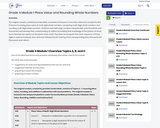
Rounding on the Hundreds Chart Mathematics Instructional Plan
- Subject:
- Mathematics
- Material Type:
- Lesson Plan
- Provider:
- VDOE
- Author:
- VDOE
- Date Added:
- 10/04/2024

Rounding on the Hundreds Chart Mathematics Instructional Plan

Rounding with Base Ten Blocks Mathematics Instructional Plans

Round numbers to the nearest ten, hundred, and thousand - Mathematics Instructional Plan

Rounding whole numbers, 9,999 or less - Mathematics Instructional Plan

Rounding: Identifying the Range Mathematics Instructional Plan

Rounding Match Mathematics Instructional Plan

Rounding with Number Lines Algebra Readiness Remediation Plan

Rounding Decimals Mathematics Instructional Plan

Use number lines or student invented strategies to round numbers to the nearest hundredth - Algebra Readiness Remediation Plan

Rounding Decimals Algebra Readiness Formative Assessment

Rounding decimals, through the thousandths, to nearest whole number, tenth, or hundredth - Mathematics Instructional Plan

Mic Drop Maths is a mathematics podcast for 5th graders based on the VA Standards of Learning. Each episode addresses one standard and is broken into segments including concept, real-world application, math history, literature connections, misconceptions, and more! There is music, sound effects, jokes, and student voice in each engaging and entertaining episode.

This video is part of the Continue to Know with WHRO TV series. Watch Emily Rathbone teach about dividing decimals.

In the first unit of Grade 3, students will build on their understanding of the structure of the place value system from Grade 2 (MP.7), start to use rounding as a way to estimate quantities (3.NBT.1), as well as develop fluency with the standard algorithm of addition and subtraction (3.NBT.2). Throughout the unit, students attend to the precision of their calculations (MP.6) and use them to solve real-world problems (MP.4).
In Grade 2, students developed an understanding of the structure of the base-ten system as based in repeated bundling in groups of 10. With this deepened understanding of the place value system, Grade 2 students “add and subtract within 1000, with composing and decomposing, and they understand and explain the reasoning of the processes they use” (NBT Progressions, p. 8). These processes and strategies include concrete models or drawings and strategies based on place value, properties of operations, and/or the relationship between addition and subtraction (2.NBT.7). As such, at the end of Grade 2, students are able to add and subtract within 1,000 but often aren’t relying on the standard algorithm to solve.
Thus, Unit 1 starts off with reinforcing some of this place value understanding of thousands, hundreds, tens, and ones being made up of 10 of the unit to its right that students learned in Grade 2. Students use this sense of magnitude and the idea of benchmark numbers to first place numbers on number lines of various endpoints and intervals, and next use those number lines as a model to help students round two-digit numbers to the tens place as well as three-digit numbers to the hundreds and tens place (3.NBT.1). Next, students focus on developing their fluency with the addition and subtraction algorithms up to 1,000, making connections to the place value understandings and other models they learned in Grade 2 (3.NBT.2). Last, the unit culminates in a synthesis of all learning thus far in the unit, in which students solve one- and two-step word problems involving addition and subtraction and use rounding to assess the reasonableness of their answer (3.OA.8), connecting the NBT and OA domains. These skills are developed further and built upon in subsequent units in which multiplication and division are added to the types of word problems students estimate and solve.

The original module, created by Eureka Math, consisted of 19 lessons. It has been altered to include the first 10 lessons involving place value of multi-digit whole numbers, comparing multi-digit whole numbers, and rounding multi-digit whole numbers. Students work with large numbers using familiar units (hundreds and thousands) and develop their understanding of millions by building their knowledge of the pattern of times ten in the base ten system on the place value chart. They learn to recognize that each sequence of three digits is read as hundreds, tens, and ones followed by the naming of the corresponding base thousand unit (thousand, and million).

In the first unit for Grade 4, students extend their work with whole numbers and use this generalized understanding of the place value system in the context of comparing numbers, rounding them, and adding and subtracting them.
Students understanding of the base ten system begins as early as Kindergarten, when students learn to decompose teen numbers as ten ones and some ones (K.NBT.1). This understanding continues to develop in Grade 1, when students learn that ten is a unit and therefore decompose teen numbers into one ten (as opposed to ten ones) and some ones and learn that the decade numbers can be referred to as some tens (1.NBT.1). Students also start to compare two-digit numbers (1.NBT.2) and add and subtract within 100 based on place value (1.NBT.3—5). In second grade, students generalize the place value system even further, understanding one hundred as a unit (2.NBT.1) and comparing, adding, and subtracting numbers within 1,000 (2.NBT.2—9). In Grade 3, place value (NBT) standards are additional cluster content, but they still spend time fluently adding and subtracting within 1,000 and rounding three-digit numbers to the nearest 10 and 100 (3.NBT.1—2).
Thus, because students did not focus heavily on place value in Grade 3, Unit 1 begins with where things left off in Grade 2 of understanding numbers within 1,000. Students get a sense of the magnitude of each place value by visually representing the place values they are already familiar with and building from there. Once students have a visual and conceptual sense of the “ten times greater” property, they are able to articulate why a digit in any place represents 10 times as much as it represents in the place to its right (4.NBT.1). Next, students write multi-digit numbers in various forms and compare them (4.NBT.2). Comparison leads directly into rounding, where Grade 4 students learn to round to any place value (4.NBT.3). Next, students use the standard algorithms for addition and subtraction with multi-digit numbers (4.NBT.4) and apply their algorithmic knowledge to solve word problems. The unit culminates with multi-step word problems involving addition and subtraction, using a letter to represent the unknown quantity, then using rounding to assess the reasonableness of their answer (4.OA.3), allowing for students to connect content across different clusters and domains (4.NBT.A, 4.NBT.B, and 4.OA.B).
Throughout the unit, students will repeatedly look for and make use of structure, specifically the structure of the place value system (MP.7). Students develop an understanding that a digit in any place represents 10 times as much as it represents in the place to its right, then apply that understanding of structure to compare, round, and add and subtract multi-digit whole numbers

Just in Time Quick Check Round to Nearest Ten

Just in Time Quick Check Round Whole Number

Just in Time Quick Check Rounding Decimals

Just in Time Quick Check Rounding Decimals